|

|
|
|
‘Spotlight on’
Silvery Kingfisher
|
|
No need to hide it. The Silvery is my favourite. Not your everyday Kingfisher with the often orangey or otherwise dullish dark bill. Not so colourful (-for a change-) but immensely delicate, a tiny little gem home to beautiful clear rivers in the Philippines –usually that is-… as I know very well, most birders have ticked it off on a murky pool in a logged over once forest –called Picop- not doing my favourite any justice indeed.
The Silvery I always like to keep up in mind inhabits crystal clear streams or rivers with plenty greenery on the banks. The Kingfisher I remember has a subtle deep black base colour out of which spring –on wings and supercilium- a row of unearthly silvery-white shiny spots. The underparts are a kind of oceanic blue hard to catch on camera. Its bill darker than pitch black, long, pointed… a weapon. The throat, loral spot and neck blaze match clean ivory white, -or cream, depending on the island and subspecies. This bird can be fast as lightning, and yes, when it shoots away, all one can notice usually is a flash of bright silver, feature of its back. This Kingfisher hasn’t stolen his name. Then, perhaps if I may, I would like to nominate our friend with a record… of contrast! Its feet. Superb indeed! They stick out with the brightest red ever, making up for whatever colour missing on the body at once. It’s got some power there. The ability to win just whatever beauty contest with ease. No man could come up create something better looking, smarter done or shaped more perfect. Now you’ve got a treasure to behold! |
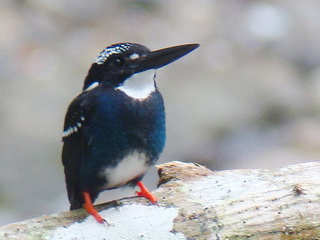 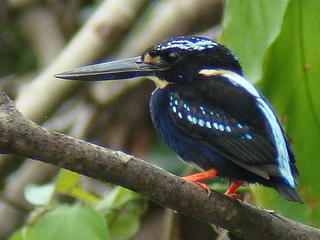 |
|
The Mindanao subspecies photographed in Zamboanga. Note cream throat, loral spot and neck blaze, Bohol. |
|
Chapter in between;
Excuse me for the description above. Maybe overdone a bit and I might be less romantic than you would think by now. See it as a good try to make people always remember it would be good to actually keep realize how wonderful nature can be. And there’s art in those who are able to enjoy it in full…
Then slightly less a favourite of mine… -factsheets- for your information yes indeed. Informative plenty; Tiny, black-and-white Kingfisher…wouldn’t it be good for Microsoft Word to invent a spellings and grammar corrector that could take out the boring bits as well? Eh, my sincere apologizes for letting myself go; factsheets do have their place in this world. So I would refer to the one I checked on for the Silvery Kingfisher. From the Birdlife Data Zone. A good collection of info for the species so I guess a job done well and should it be that you recognize any critics on this page they won’t refer to Birdlife. They’ve just only gathered info from others you see and put it together, fair enough. Old info. Some of it valid still, some of it dated. Incomprehensive I see so that may confirm again how little we actually do know, although I reckon it won’t be easy to hear that out of any scientist. Give things a place, box them in, give it a number, an explanation, a size, a habitat, a colour… kind of failed once again. Good to know stuff and good to have some understanding. But I feel sorry though, for those who dedicate their lives on just only this. For those who can’t put things to a wider context, see with a broader mind, enjoy things indeed and let them be what they are, keep things wonderful! Let’s read again “The chapter in between.”
Something else about the factsheet… see for yourself. It is composed decidedly negative and depressing. I strongly believe they’ve well overdone that! Factsheets aren’t my favourite you know. Ha come on, you don’t need an example; A little copied and paste follows, frankly. I guess the authors don’t mind the copyright for lines that do not make much sense in the first place. Looks as if even when they finally do find a place and tell us the Kingfisher is well protected therein, still have to add something negative. What’s it gonne be then? Protected or not protected? “While populations in Pasonanca (10,560 ha; Zamboanga City) and Malagos Watersheds (235 ha, Davao City) are well protected by armed guards patrolling the watershed, doubts remain over how well these sites are managed and protected.” Or did they mean the guards would use armed force against anyone harming a Kingfisher but wouldn’t mind you to cut a tree? I’m not really getting it, do you?
As it happens, folks, I’ve just returned from a most enjoyable visit to Pasonanca/Zamboanga. They have 21 forest stations each with 3 armed guards on duty. Seen the automatic rifles and shot guns. I can tell you safely. No ant that dares cut a tree or harm a bird within the protected forest! Isn’t it like a disease that talk (by westerners at least) about conservation in Philippines always and always has to come negative??? Isn’t it? Make it look there’s only the last trees standing? Perhaps the only way around is visit and see for yourself. We do have some good protected forest and superb birdwatching sites in the Philippines indeed! |
|
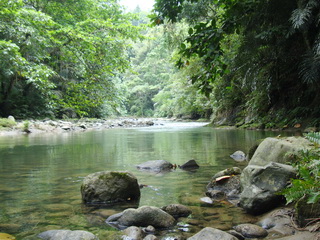
|
|
Silvery Kingfisher habitat at Pasonanca Watershed, Zamboanga. |
|
No, I haven’t studied the Silvery Kingfisher. I won’t, and for good reason. But I’ve been out in the field, more possibly than those who actually studied the Silvery so it’s obvious I’ve got some information to share. Let me keep it short though before Microsoft does come up with a “boring” corrector indeed. On the other hand, if it does get you excited if I tell you I found Silvery Kingfisher on an island it was not supposed to be you may actually wish to continue read. If you need a direct link to this, it’s near the bottom of the page.
So, if you’ve got the factsheet opened in a separate tab it will be easy to follow and compare. Before you proceed do remember that “the facts are in the sheet” and that on this page only appears what I may be free to personally think or believe. Stuff unstudied and not proved is below and there’s no need for you to confront or challenge me with anything. Enjoy things wonderful right!
-Vulnerable;
Vulnerable I feel could be data deficient. Lots of southern Philippines lies in some of the wettest corners on this earth which easily explains the sheer number of rivers and streams (most of them inaccessible along decent stretches) coming down from the mountains. I’m not so sure about the small population. The assumed rapid decline posted appears to be made up guessing indeed as I see lower down the page only c.10 sites for Silvery were confirmed since 1980. Come on. Those guys have to come out from behind their lofty desks and go enjoy a nice stroll out in the field!
The (trend) justification doesn’t seem to specifically refer to the species that the factsheet is about. (See below in first lines under ‘Biliran’) Generalise the total destruction of nature in Philippines and build on that to get threats to Silvery Kingfisher justified… come on people, be positive somewhat more please!
“Loss of forested lowland stream habitats.” Silvery does not need (proper) forest as you may read in the factsheet and I would like to confirm that. (I’ve seen it forage even in a rice paddy my dear!) It isn’t confined to strict lowlands and inhabits larger rivers and pools as well…mmm
-Population;
What a guess ha. They haven’t got a clue. Neither do I. But I told you the ‘facts’ are in the sheet... Sorry for that.
-Threats;
If they talk Bohol at 4% at the start of the chapter that must be the most negative estimate I’ve seen so far, actually one would think they must have forgot some forest then. Rajah Sikatuna, -and indeed the larger forest block called Loboc Watershed Reserve that nobody seems to know- are well protected. Not sure if “leased to logging concessions or mining applications” in the next line was meant specifically to reserves on Bohol but looks like it and I would rather believe this to be complete nonsense then. Desperate to proof ‘vulnerable’ would be justified? Add some negativity perhaps? Then, Picop on Mindanao is a logging concession and as you may know such is there to cut the trees would it not? Nothing to do about that. Same in Malaysia, Indonesia, everywhere. Case closed, stop complain.
Ok then, the above isn’t much worth or important. No need to discuss. The heart of the thing here in this chapter is that both sites on Bohol and at Picop very much are the old known spots where everyone goes to see the species. They are NOT key sites for the Silvery Kingfisher. Maybe Picop or beyond in some far away corners, I don’t know, but certainly not where birders go to visit it. (This murky small pool comes up in my mind again.) Bohol may have some good forest left but hasn’t at all that many rivers and streams as it doesn’t feature any mountains that would catch lots of rain. Silvery Kingfisher habitat on Bohol is limited and numbers would be insignificant if the whole population is taken into account.
Leyte, Samar and parts of Mindanao must be the stronghold. And perhaps another island I tell you about below. Not unsurprisingly these are all places seldom (or not at all) visited by birders. I assume there has been done a good job on the factsheet with the available information. In the field things look different though.
|
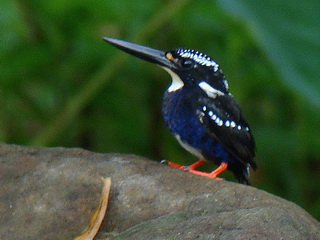 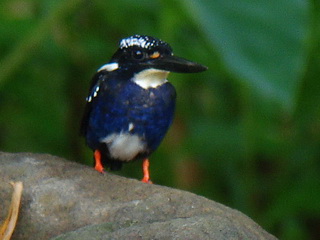 |
|
Couple photos from Biliran. Note cream loral spot but white throat and neck blaze... |
|
The island it wasn’t supposed to be; Biliran.
Keep an eye on those streams and rivers. With in most places plenty vegetation on the banks it remains the best habitat below the altitude of 400 - 500m on the island anyway!!! So wouldn’t it be a pity for no Kingfisher to be here??? Yes, the common ones –Collared, White-throated, Common Kingfisher are around. A couple mini-expeditions to attempt something more rare had already nestled somewhere in a corner of my thoughts, but there’s so many things to do and on this morning I was about to go check out on what is probably the only easy accessible bit of forest on the whole island. I had glimpsed the rare Rufous-lored Kingfisher here once and it’s him I was after this morning. Success on this had to wait though, as en-route, a couple bridges serve and bring you to the other side. While getting across, there seems to be no choice for me, it is printed in and automatic. I just ‘have’ to get a quick look left and right scanning the clear stream. Plenty rocks and overhanging branches make for ideal perches. Right side. Still doing about 30km an hour on the motor but the same word came out together, from my wife and me, -“kingfisher”! She knows the commoner kingfisher species but it was her first Silvery. Later, she would go on with me to find Silvery Kingfisher at another previously unknown spot on the island of Leyte, well up in the hills at an altitude of 700m above see level there.
|
|
N 11° 34.761’ E 124° 27.582’
183 meters above sea level |
|
Once again and 1 more time. This page isn’t about criticism of a factsheet. I actually find the Birdlife/Red List factsheets nicely done and they have some interesting information that would otherwise be totally unavailable in the first place. Nothing is perfect or complete. Not everything always makes sense or is made up of logic thinking. Perhaps this page isn’t and may be ripe for critics. But that’s not what this is about. I don’t care so much about the facts in the sheet, the info wrong or just, old or updated, and I don’t want to put or receive any critics. To refer to the factsheet may only just make us realize how little we actually do know about nature.
Let me just hope my ‘in focus’ is an interesting bit of text and composed in such way that people will actually do read. Stuff for thoughts. If any new info comes along good. But let us most important of all my friends, hope you simply enjoyed the page. And make sure you get to enjoy watch a Silvery Kingfisher at least once in your life! |
|
|
Copyright  Birding2asia.com Birding2asia.com  All rights reserved. This page published 18 September 2011. All rights reserved. This page published 18 September 2011. | |